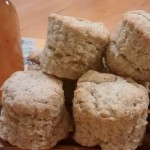Poetry is the achievement of the synthesis of hyacinths and biscuits. ~Carl Sandburg
Did you know that baking powder, the key leavening ingredient in most biscuit recipes, wasn’t invented until 1854?
Prior to that time, bakers were limited to yeast-leavened baked goods, which were time consuming. The other alternative, the use of whipped eggs to create rise, was notoriously finicky.
By the late 1700s, an enterprising baker had discovered that pearlash (a purified form of potash) combined with soured milk created a chemical reaction that led to the release of carbon dioxide. By capturing the gas through combining the two ingredients in baked goods, bakers were able to create ‘quick breads’.
One problem with this method, however, was that pearlash had a nasty, bitter aftertaste.
Still, the excitement generated by the new approach led to further experimentation.
Pearlash was soon replaced by ‘Saleratus’, which was pearlash with the addition of carbonic acid. This changed the chemical composition of the pearlash (potassium carbonate) to potassium bicarbonate. This new chemical configuration appeared to lead to more palatable goods and increased in popularity until the early 1800s, when sodium bicarbonate (or baking soda) was introduced.
Baking soda was an improvement over the earlier leaveners, but was unpredictable because its effectiveness depended on the acidity of the sour milk it was mixed with. The addition of cream of tartar in the 1830s provided more predictable results, and was the beginning point in the development of baking powder.
Using baking soda and cream of tartar was challenging because the ingredients had to be stored separately before baking, and both were activated immediately once mixed with the liquid in a dough or batter. The supply of cream of tartar was also sporadic, which meant that it was often very expensive when it was available.
Chemist Ebon Horsford solved this dilemma of availability by replacing the cream of tartar with calcium acid phosphate, but the problem of premature activation remained. Horsford then realized that he could avoid this reaction by mixing the two ingredients with cornstarch. The cornstarch kept the compounds separate and delayed the chemical reaction, giving cooks a bigger window of opportunity for success in the baking process.
Horsford patented his baking powder in 1854 and it was at first marketed under his name. Later, it was sold as the better known Rumford Baking Powder.
Baking powder was a boon to home cooks and helped make the production of baked items like cookies and biscuits easier and more reliable.
This recipe for DIY Biscuit Mix relies on the chemical magic of baking powder to help produce high-rising biscuits. It also uses a mixture of all-purpose and whole wheat flours for texture and olive oil for richness and flavor. Use a baking powder without aluminum for better taste.
This recipe makes enough for seven batches of biscuits, so you can whip them up at a moment’s notice. Store the prepared mix in the fridge for up to 4 months.

- 6 cups all-purpose flour
- 6 cups whole wheat flour
- 3/4 cup sugar
- 2 tablespoons salt
- 6 tablespoons baking powder
- 1 tablespoon baking soda
- 1-1/2 cups skim milk powder
- 2 cups olive oil
-
In large bowl, stir all ingredients except olive oil together. Mix until thoroughly combined.
-
Pour olive oil over dry ingredients and cut in with a pastry blender or stir with a spoon until the mixture becomes crumbly and there are no wet looking lumps in the flour.
-
Stir thoroughly.
-
Measure 2-1/4 cups into 7 ziplock bags or small jars, or store mix in one large container. Refrigerate until ready to use.
-
For each batch of biscuits (using 2-1/4 cups of mix) add 1/2 to 2/3 cup of water to make a soft dough.
-
If needed, knead lightly on floured board to make a dough firm enough to roll or pat out without sticking.
-
Cut with a 2-inch cutter and place on ungreased baking sheet. Each batch will make approximately 18 biscuits. Place unbaked biscuits close together on baking sheet.
-
Bake in preheated 400 degree F oven for 12 minutes until risen and lightly browned.
-
Let cool on wire rack for 5 minutes before serving.
If you prefer, you can use shortening in place of the oil in this recipe.
Leave a Reply